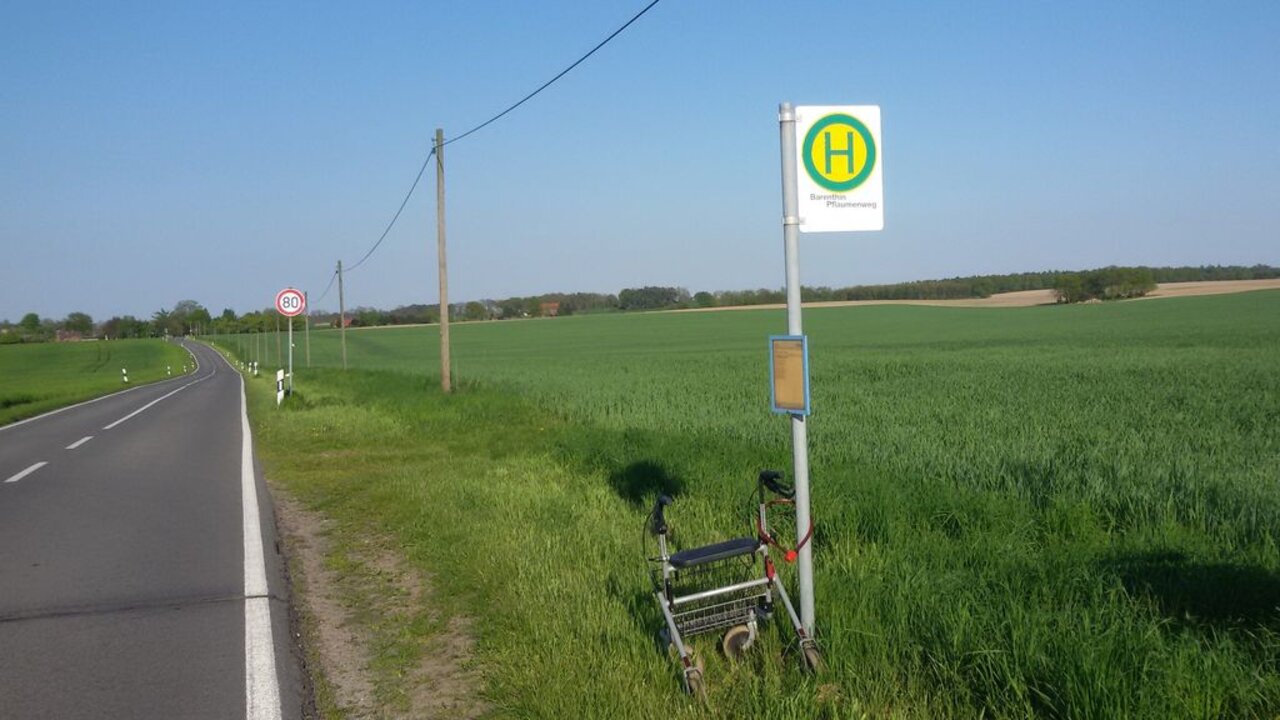Project
Social Disadvantage in Rural Peripheries in Eastern Germany and the Czech Republic

Social disadvantage in rural peripheries in eastern Germany and the Czech Republic: opportunity structures and individual agency in a comparative perspective
Processes of social disadvantage are often considered as urban problems, but such phenomena are also prevalent in rural areas. In the project we analyse patterns of social disadvantage and options for action.
Background and Objective
Rural regions have recently (once again) moved into the focus of political and media discourse – not only in Germany, but also in other European countries and in the USA. The debate focuses on the notion that rural areas are particularly affected by social disadvantage, a lack of infrastructure as well as structural economic and demographic problems. Such topics have also been on the scientific agenda for quite a while long time. In Germany, they are primarily associated with the concept of peripheralisation, i.e. with a dynamic and multidimensional understanding of the disadvantages of certain rural areas.
While the structural problems of rural peripheries as well as the discourses on them are well analysed, the question of the coping strategies of disadvantaged social groups has not yet been answered empirically. In the project we are particularly interested in whether and how the presence or lack of certain public and private services (e.g. public authorities or doctors’ surgeries) in the local and regional environment impact on the daily lives of these social groups. We also want to know in more detail what role people’s social networks play in cushioning or reinforcing social disadvantage. In addition, we investigate how processes and structures of social and spatial inequality interact precisely and how they influence the possibilities of individual actors to act and to cope with their situation.
Approach
In this project we analyse the interactions between social disadvantage, local and regional opportunity structures – such as public and private services of general interest, but also jobs or local associations – and individual scope for action. We are interested in the effects of processes at the societal macro level on patterns of social and spatial inequality. The meso-level includes local and regional opportunity structures as well as people’s social networks. At the micro level, we examine the individual agency's scope for action and how it deals with the structural conditions of the spatial environment.
A descriptive quantitative analysis of the spatial patterns of social disadvantage in East Germany and the Czech Republic is followed by in-depth regional case studies and qualitative interviews with representatives of disadvantaged social groups. In the last part of the project, comparative analyses are carried out both between the case study regions and between eastern Germany and the Czech Republic.
Data and Methods
In the project we first conducted small-scale statistical secondary analyses of all rural areas. Their aim was to identify rural peripheries in eastern Germany and the Czech Republic, to analyse the availability and accessibility of local and regional opportunity structures and to investigate current regional dynamics in socio-economic terms. For this purpose we used data from official regional statistics as well as the Thünen Accessibility Model.
Building on this, two different rural peripheries in eastern Germany and the Czech Republic were examined in more detail with regard to the interrelations between social disadvantage, opportunity structures and the individual’s opportunities to act (agency). This was done via a mixed-method design that combines expert interviews with regional stakeholders and qualitative problem-centred interviews with members of socially disadvantaged groups. The problem-centred interviews also examined people’s social networks and individual time-space activity patterns. Re-interviews finally served to interpret these time-space data and the interrelations between local and regional opportunity structures, social networks and individual’s opportunities to act.
Results
The project contributes to the sociological debate on the role of neighbourhood effects on social action and, in doing so, to the issue of the interdependencies between social and spatial disadvantage. Empirically, the relevance of local and regional opportunity structures in rural peripheries for individual behaviour and societal inclusion of socially disadvantaged groups. By way of comparing the situation in two different European countries, the research results are continuously reflected and tested for their validity.
![Poster: Handout [Translate to English:] Poster zum Projekt](/media/_processed_/b/8/csm_Handout__aktualisiert_Nov_2018_df8797cc20.png)
Poster presented at the international conference EURORURAL '18, September 3rd-6th, 2018, Mendel University, Brno, Czech Republic.
Poster (pdf, limited accessibility) 1067 KB
Thünen-Contact

Involved Thünen-Partners
Involved external Thünen-Partners
-
Soziologisches Institut der Akademie der Wissenschaften der Tschechischen Republik, Abteilung für Lokal- und Regionalstudien
(Prag, Tschechische Republik)
Funding Body
-
Deutsche Forschungsgemeinschaft (DFG)
(national, öffentlich)
Duration
8.2018 - 10.2022
More Information
Project status:
finished
Publications to the project
- 0
Keim-Klärner S, Bernard J, Decker A (2025) How do single mothers evaluate and cope with living in rural peripheries? Insights into the interplay of social and spatial disadvantage. Rural Sociol 90(1):24-84, DOI:10.1111/ruso.12586
- 1
Keim-Klärner S (2024) Lebenswelten von Familien: Aktuelle Entwicklungen und Herausforderungen für soziale Dienste. In: Wendt WR, Faulde J (eds) Wohlfahrtspflege im ländlichen Raum: Herausforderungen für Sozialpolitik und Soziale Arbeit. 1. Auflage. Baden-Baden: Nomos, pp 169-184, DOI:10.5771/9783748917625-169
- 2
Bischof S (2024) Soziologie des Alltags: Staat in ländlichen Räumen als komplexes Verhältnis. 10 Minuten Soziol 9:19-32, DOI:10.14361/9783839465233-002
- 3
Dülmen C van, Simon M, Bischof S, Bernard J, Keim-Klärner S, Decker A, Danková H, Eysholdt M, Klärner A (2024) The mobility interview: Triangulating interview and global positioning system data to explore the role of mobility in everyday life. Int J Qualitative Methods 23, DOI:10.1177/16094069241251535
- 4
Bernard J, Keim-Klärner S (2023) Disadvantaged and disadvantaging regions: Opportunity structures and social disadvantage in rural peripheries. Tijd Econ Soc Geogr 114(5):463-478, DOI:10.1111/tesg.12589
- 5
Bischof S, Decker A (2023) Out of balance? Understanding resident-municipality relations in rural peripheries through ascriptions of responsibility. J Rural Studies 97:281-289, DOI:10.1016/j.jrurstud.2022.12.013
- 6
Bernard J, Steinführer A, Klärner A, Keim-Klärner S (2023) Regional opportunity structures: A research agenda to link spatial and social inequalities in rural areas. Prog Human Geogr 47(1):103-123, DOI:10.1177/03091325221139980
- 7
Keim-Klärner S, Bernard J, Bischof S, Dülmen C van, Klärner A, Steinführer A (2023) Sozial Benachteiligte in ländlichen Peripherien in Ostdeutschland und Tschechien: doppelt erschwerte Bedingungen für die Alltagsbewältigung? Z Agrargeschichte Agrarsoziologie 71(1):95-109
- 8
Dülmen C van (2022) Alles anders und doch gleich - Fragile Alltagsmobilität sozial benachteiligter BewohnerInnen ländlicher Peripherien vor und während der Covid-Pandemie. J Mobil Verk 14:43-51
- 9
Bischof S, Lengerer F, Meyer F (2022) Interaktionsspuren im digitalen Raum : zum Spannungsfeld von Öffentlichkeit und Anonymität in qualitativen Forschungsprozessen. Forum Qual Sozialforsch 23(3):9, DOI:10.17169/fqs-23.3.3893
- 10
Viry G, Dülmen C van, Maisonobe M, Klärner A (2022) On the role of space, place, and social networks in social participation. Soc Inclusion 10(3):217-220, DOI:10.17645/si.v10i3.6186
- 11
Dülmen C van, Klärner A (2022) Places that bond and bind: on the interplay of space, places, and social networks. Soc Inclusion 10(3):248-261, DOI:10.17645/si.v10i3.5309
- 12
Dülmen C van, Simon M, Klärner A (2022) Transport poverty meets car dependency: A GPS tracking study of socially disadvantaged groups in European rural peripheries. J Transp Geogr 101:103351, DOI:10.1016/j.jtrangeo.2022.103351
- 13
Keim-Klärner S, Steinführer A, Dülmen C van (2022) Und wenn die Peripherie peripherisiert bleibt? : Alleinerziehen während der Covid-19-Pandemie. Ländliche Räume Beitr Lokalen Regionalen Entwickl 9:129-145
- 14
Keim-Klärner S, Bernard J, Bischof S, Dülmen C van, Klärner A, Steinführer A (2021) Analyzing social disadvantage in rural peripheries in Czechia and Eastern Germany : conceptual model and study design. Braunschweig: Johann Heinrich von Thünen-Institut, 52 p, Thünen Working Paper 170, DOI:10.3220/WP1614067689000
- 15
Knabe A, Keim-Klärner S, Klärner A, Neu C (2021) Lebenschancen in ländlichen Räumen: Gelegenheitsstrukturen als Dimension sozialer Ungleichheit. In: Hoffmann R, Knabe A, Schmitt C (eds) Ungleichheit, Individualisierung, Lebenslauf : Zur Aktualität Peter A. Bergers. Wiesbaden: Springer Fachmedien, pp 141-163, DOI:10.1007/978-3-658-34223-4_7
- 16
Steinführer A (2020) Daseinsvorsorge in ländlichen Räumen. Zwischen Abbau, Umbau und Ausbau. In: Becker S, Naumann M (eds) Regionalentwicklung in Ostdeutschland : Dynamiken, Perspektiven und der Beitrag der Humangeographie. Berlin: Springer Spektrum, pp 375-387, DOI:10.1007/978-3-662-60901-9_29
- 17
Klärner A, Knabe A (2019) Social networks and coping with poverty in rural areas. Sociologia Ruralis 59(3):447-473, DOI:10.1111/soru.12250

![[Translate to English:] [Translate to English:]](/media/_processed_/2/0/csm_LV_Bei_Hornburg_Quelle_Johanna_Fick_neu_da89674833.jpg)
![[Translate to English:] [Translate to English:]](/media/_processed_/2/0/csm_LV_Bei_Hornburg_Quelle_Johanna_Fick_neu_3aae309567.jpg)





